Source: Pantera Capital April 2025 Blockchain Letter
Author: Cosmo Jiang, Partner of Pantera Capital; Compiler: AIMan@Golden Finance
In 2025, a series of events in the cryptocurrency space and the broader macro environment have had an impact on the market. Large macro forces are clearly dominant, and risk appetite continues to decline in most industries and asset classes. While digital assets are leading the way in growth-oriented investments, they are far from immune to their impact.
2025 started optimistically, with political attitudes turning toward cryptocurrencies, driving cryptocurrency prices up from the election in November last year to January this year. However, after Bitcoin and Solana hit all-time highs in January, Trump's inauguration turned into a typical "buy the rumor, sell the news". Both the S&P 500 and Bitcoin fell 15-20% (although Bitcoin has since recovered). But if you look internally, high-growth and small-cap stocks have fared even worse. For example, Ethereum, the second-largest coin by market cap, is down 47%. The pullback can be largely attributed to macro factors, as well as some issues specific to digital assets.
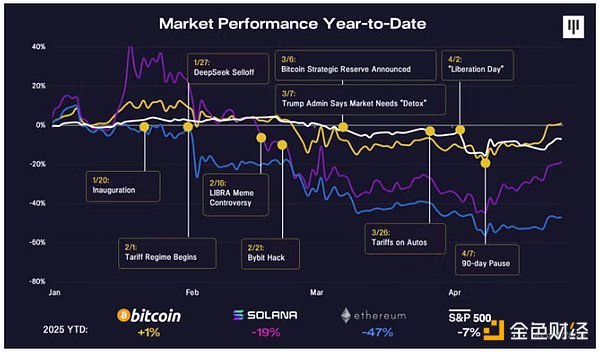
From a macro perspective, the market is concerned about increasing policy uncertainty and stagflation, a combination of slowing economic growth and rising inflation. Trump continues to push through his tariff plans (currently, there is a 90-day suspension of "reciprocal" tariffs above the 10% base rate, excluding China), which has already lowered consumer confidence, corporate earnings, and GDP forecasts. This started with his first executive order at his inauguration, but the market didn't really take him seriously until the first round of tariffs against Mexico, Canada, and China took effect on February 1. Since then, every major tariff announcement has led to a market decline, culminating in “Liberation Day” on April 2.
While tariffs have been the biggest driver of price action, other headwinds have also emerged, such as the Department of Government Efficiency (DOGE). The impact of DOGE is difficult to quantify, but qualitatively it has had a significant impact on the mentality of government employees and the businesses that serve the government. Given that government spending has accounted for 23% of GDP and 25% of new jobs in recent years, any DOGE-driven spending cuts will have a real short-term impact on the economy. Whether these policies are good or bad, the speed and magnitude of change are very different from previous administrations. The market is worried about uncertainty, and we have seen the default reaction: sell off and take more defensive positions.
In addition, the stock market has been supported by optimism about unlimited demand for AI hardware from a fundamental growth perspective. But this optimism took a hit after the market began to digest the impact of DeepSeek's achievements. All public AI-related stocks - and AI-related tokens - sold off sharply, with many falling by more than 50%.
The digital asset industry has also faced some unique challenges. First was the bursting of the memecoin bubble. This decline began after Trump launched his own memecoin, and accelerated further after the uproar over Argentinian President Javier Milei and the manipulated LIBRA memecoin.
There has been much debate about whether these events are good or bad—perhaps both. On the bright side, high-profile figures like Trump are bringing attention and new users to the space, inspiring copycats from the Web2 world. Tokens are the most disruptive form of capital formation we have ever seen, and I hope this inspires more creative and productive token launches in the future.
On the other hand, meme coins reinforce the casual observer’s perception of cryptocurrencies: that they are full of scams and a joke, which damages the reputation of developers who are serious about building cryptocurrencies. They also siphon liquidity and attention away from other tokens. And, because meme coins are often extractive, it is difficult for other tokens to recover once the frenzy fades.
The second-largest outlier of the quarter was the hack of Bybit, the world’s second-largest exchange. While no customer funds were lost — Bybit successfully recouped the losses — it still undermined confidence in the overall market structure.
When you put all of these events together, you can see how they dragged down the market.
Crypto Price Performance
The sell-off was broad-based. The median token price fell by more than 50% in the first quarter, and almost 100% of tokens are down year to date. Note that this price action is similar to that of the S&P 500 and its underlying constituents.
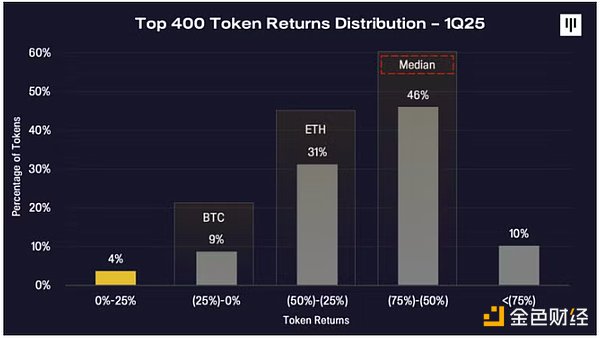
We believe that the market is increasingly focusing on tokens with solid fundamentals, and we are seeing this trend reflected in relative performance. Fundamentally solid tokens (i.e. tokens with revenue and cash flow) have outperformed tokens without revenue by 8 percentage points year-to-date. Memecoin and AI have also underperformed other tokens.
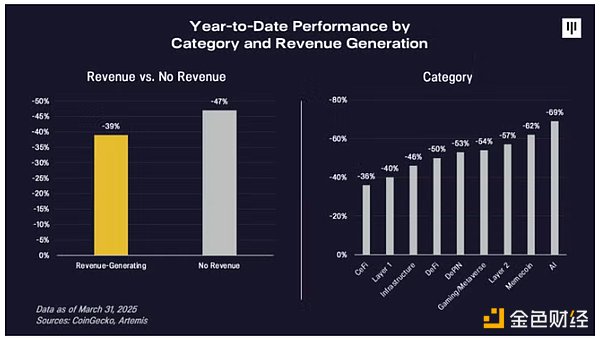
As painful as it may be, we believe that capital destruction of fundamentally worthless tokens is healthy.
Price performance, put in historical context
We have experienced similar pullbacks many times before. This is common in broader bull markets.
During the last uptrend from 2020 to 2022, BTC had five major pullbacks of more than 20%. Other tokens have experienced pullbacks of 40% to 50%. Even in strong markets, this happens from time to time. We’ve already had three such pullbacks in the current long-term uptrend—including the one we’re in now. Each time, getting shaken out was a mistake. In fact, in the past week, the price of Bitcoin rallied back to $95,000, with most of the gains occurring on Wednesday. For those with a long-term investment horizon, being able to withstand this kind of volatility is a huge advantage.
When analyzing quarterly changes in cryptocurrency market capitalization, large declines are usually followed by strong rebounds, as indicated by the arrows.

Q1 2025 was the worst quarter for cryptocurrencies since the summer of 2022, when markets plunged across the board. While past experience may not predict the future, large declines are almost always followed by strong rebounds - although the magnitude of the rebound depends on current market conditions and, crucially, whether the overall trend can remain upward.
Are you greedy when others are fearful?
On April 15, 2025, I hosted a Crypto Market Outlook call to discuss my thoughts on the cryptocurrency markets. I talked about some of the indicators tracking market sentiment that we believe have reached all-time highs, indicating that some of the worst of the sell-off is over. While the market did rebound from the bottom, I wanted to share my thought process on how I was monitoring market sentiment at the time:
“The U.S. Economic Policy Uncertainty Index is at a 40-year high, similar to levels seen during the COVID-19 pandemic, and higher than at any time since the survey began in the 1980s, including higher than levels seen during 9-11 and the 2008 financial crisis.
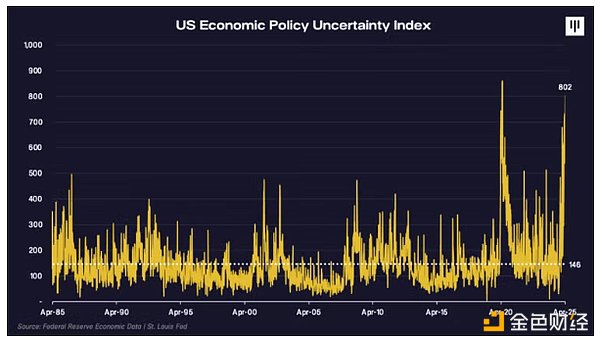 Uncertainty causes risk allocators to retreat. At this juncture, you need to ask yourself if the environment is going to become more uncertain. Based on historical context, this scenario seems unlikely and instead we should have reverted to the mean.
Uncertainty causes risk allocators to retreat. At this juncture, you need to ask yourself if the environment is going to become more uncertain. Based on historical context, this scenario seems unlikely and instead we should have reverted to the mean.
“The Crypto Fear and Greed Index takes into account a variety of factors such as technical momentum and social media sentiment to calculate an overall index score of the degree of greed and fear among market participants.
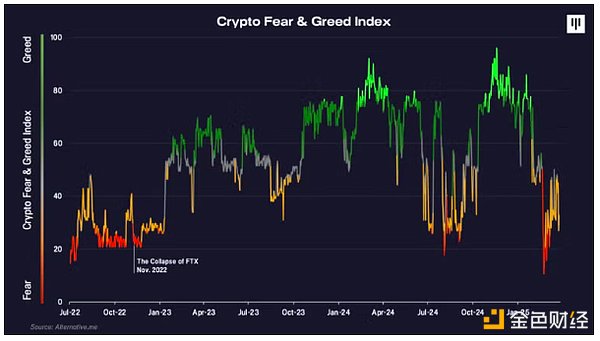
“During the sell-off, we once again fell into the lowest level since the bear market low and the end of 2022 FTX Extreme levels of fear not seen since the crash. Whenever the market reaches such extreme levels, negative sentiment usually signals a local bottom in prices and a good point for future returns.
Next is the Bitcoin Futures Funding Rate, which shows the ratio of long and short participants in the futures market. The Binance Bitcoin Futures Funding Rate shows that there are more shorts than longs in this market. This has only happened during market downturns in previous cycles, and usually precedes a major rebound, like in late 2023 and 2024.
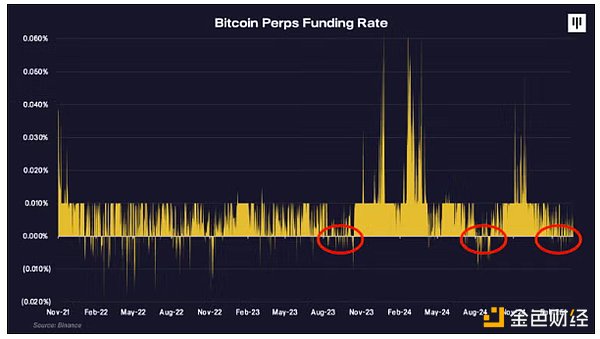
The final indicator is the American Association of Individual Investors (AAII) Investor Sentiment Survey - A weekly survey conducted by the American Association of Individual Investors (AAII) shows that more than 60% of investors are pessimistic about the next six months. This has only happened three times since the survey began in the 1980s, during the sharp market corrections in 1990, 2008, and 2022.

To summarize the current market sentiment, these charts show that
– Cosmo Jiang, General Partner, Pantera Capital, Crypto Market Outlook Call
The Impact of Macro Events on Cryptocurrencies
Interest Rates and Liquidity Conditions Are Favorable for Risky Assets
At the same time, favorable interest rates and liquidity conditions are favorable for risky assets.
The 10-year Treasury yield has been steadily declining since hitting a high in 2023, and the decline has been rapid in recent days. Interest rates have remained high for longer and may continue to remain so in the context of high inflation, but more importantly, the overall trend is downward. The Trump administration—particularly Treasury Secretary Bessant—has spoken about the importance of lowering long-term interest rates, and their policy actions are intended to achieve this goal. Lower long-term interest rates are critical to keep the U.S. spending financed and are good for risk asset valuations.

Global liquidity conditions are also continuing to increase. Europe and China are now implementing stimulus measures after a period of tightening. We may be on the verge of a shift to quantitative easing. Both Treasury Secretary Bessant and Fed Governor Collins have spoken on this in the past few weeks in response to the bond market turmoil caused by the surge in long-term bond yields. Their natural response will be to provide liquidity support, when the world's largest economies will work together. Increased liquidity is good for risk assets.
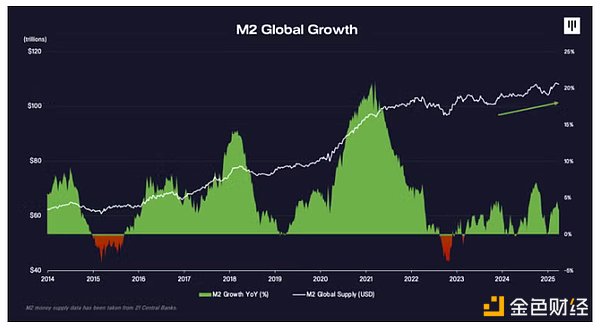
If we compare global liquidity to Bitcoin price, it is clear that the main upward trends in Bitcoin price occur during periods of increased liquidity. During periods of stress, which are usually caused by tightening liquidity, Bitcoin will fall back along with all other assets. Therefore, we believe that the rise in global liquidity is an important indicator worth monitoring.
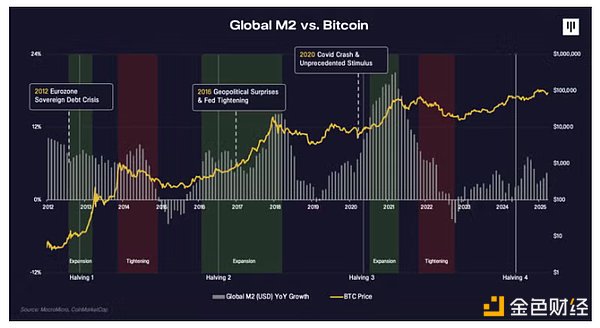
Another perspective on the four-year cycle of cryptocurrency
This is a historic moment for the global economy: the S&P just had its worst week and its best week - back to back. Typically, Bitcoin's price sees major moves in response to major macro events, which also typically coincide with global liquidity cycles. In 2012, it was the Eurozone sovereign debt crisis. In 2016, it was Brexit. In 2020, it was the economic collapse brought on by the COVID-19 pandemic. Many people blame the halving for Bitcoin’s price cycles, but another explanation is that every four years some major macroeconomic event happens to support Bitcoin’s bull run. We are at one of those moments again.
Recent macroeconomic events are turning into a crisis of confidence in the U.S. dollar. Many point to rising long-term Treasury yields as a harbinger of bond market turmoil or capital flight as foreign companies and entities move savings out of the U.S. dollar. Bitcoin’s primary function is that it is a non-sovereign store of value. This does not necessarily mean that the price must be stable, but it is seen as an attractive alternative and diversification tool in an increasingly uncertain world. This de-dollarization certainly reinforces this thesis.
Early Signs of Relative Strength in Cryptocurrencies
We are starting to see signs of digital assets performing better over a short period of time. So far in April, digital assets have performed relatively better than stocks and the dollar. Solana and Bitcoin rose while US stocks fell. It's early, but just as digital assets were the first to pull back, they may also be the first to bottom out.
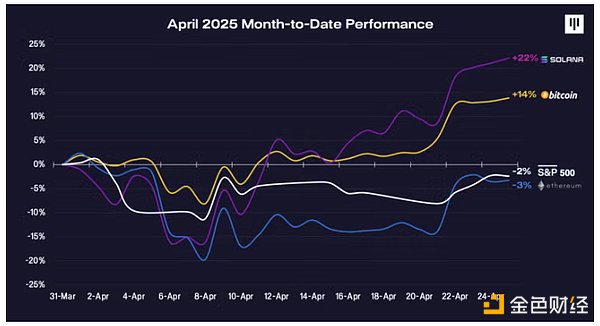
Positive Industry Developments Ignored
In addition, we should keep in mind that many positive industry developments are being overlooked amid price volatility. In terms of policy actions, this includes the White House appointing a “crypto czar” and establishing a digital asset task force, establishing a strategic bitcoin reserve, revoking strict regulations such as SAB-121 and the DeFi broker rule, and the SEC dismissing more than a dozen lawsuits against large companies. It can be said that the cryptocurrency industry has experienced the most positive news headlines in history, many of which are structural changes, and yet it has experienced its worst quarter since 2018. We believe that this good news is definitely not priced into the market and is simply ignored by market fluctuations.
Fundamentals are improving
Above all, digital assets need real adoption and use to sustain. Blockchain companies are currently generating billions of dollars in revenue. Real Economic Value (REV) - a measure of total demand and value capture for L1 blockchains - was $1.5 billion last quarter, an annualized $6 billion. During the same period, total revenue for on-chain applications was approximately $3 billion, an annualized $10 billion. Daily active addresses (a measure of user activity) continue to hit new highs. As more and more people choose to use cryptocurrencies for payments and savings, stablecoins and on-chain stablecoin transfer volumes have also hit record highs. Innovation in key investment focus areas such as stablecoins, artificial intelligence, DePIN and DeFi continues to be strong in the early stages. We expect these fundamental indicators to show an upward trend as more and more people discover the exciting applications and opportunities provided by the chain.
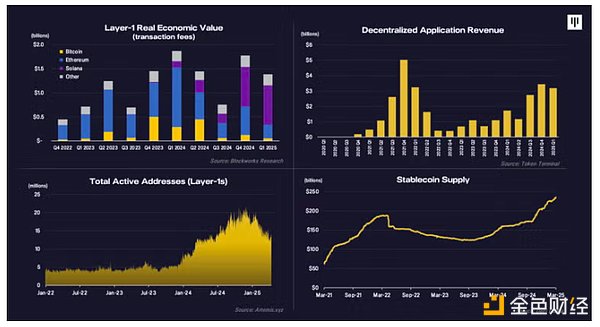
Conclusion
In summary, it was a challenging quarter, with huge macro forces clearly dominating and causing risk appetite to retreat sharply. The biggest hidden danger remains the uncertainty surrounding tariffs and their impact on the global economy. The market outlook remains highly uncertain, which is reflected in sentiment indicators that are at historically low levels. However, these sentiment signals also suggest that we may have passed the most aggressive point of selling.
After we get through this tariff-driven volatility, I believe investors will begin to appreciate all of the long-term tailwinds and strong fundamentals, and I still expect digital assets to perform strongly this year. As the vanguard of growth assets, cryptocurrencies were the first to pull back, but they may also be the first and fastest to rebound.
 Catherine
Catherine





 Uncertainty causes risk allocators to retreat. At this juncture, you need to ask yourself if the environment is going to become more uncertain. Based on historical context, this scenario seems unlikely and instead we should have reverted to the mean.
Uncertainty causes risk allocators to retreat. At this juncture, you need to ask yourself if the environment is going to become more uncertain. Based on historical context, this scenario seems unlikely and instead we should have reverted to the mean. 










